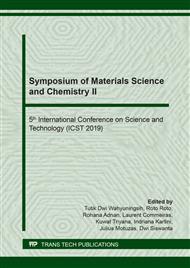p.245
p.251
p.257
p.265
p.270
p.277
p.284
p.293
p.300
Discovery of Natural Product Compounds as Dengue Virus NS5 Methyltransferase Inhibitor Candidate through in Silico Method
Abstract:
Dengue is a global health problem which predominantly affected the tropical and subtropical region of Asia, Africa, and America. However, there are no available antiviral agents to treat dengue virus (DENV) infection. This study was conducted to utilize natural product compounds as an inhibitor of NS5 Methyltransferase, a viral protein which plays an essential role in the synthesis of DENV RNA. The natural product compounds were collected from the Universal Natural Product Database (UNPD), totaling 229,000 compounds. The in silico screening of the natural product compounds was performed by molecular docking simulation method, which simulates the interaction of the compounds on the active site of the NS5 methyltransferase. From the molecular docking simulation, about 51 compounds showed better affinity and interaction compared to the standard compound, S-Adenosyl-L-Homocysteine (SAH). Then, a series of pharmacological tests were performed to find the best drug candidates by employing DataWarrior and SwissADME software. Finally, three natural product compounds, namely UNPD98966, UNPD183023, and UNDP104952, were regarded as the best inhibitor against NS5 methyltransferase based on its molecular affinity and interaction. These compounds also showed potential as drug candidates due to their desirable pharmacological properties.
Info:
Periodical:
Pages:
270-276
Citation:
Online since:
April 2020
Price:
Сopyright:
© 2020 Trans Tech Publications Ltd. All Rights Reserved
Share:
Citation:


